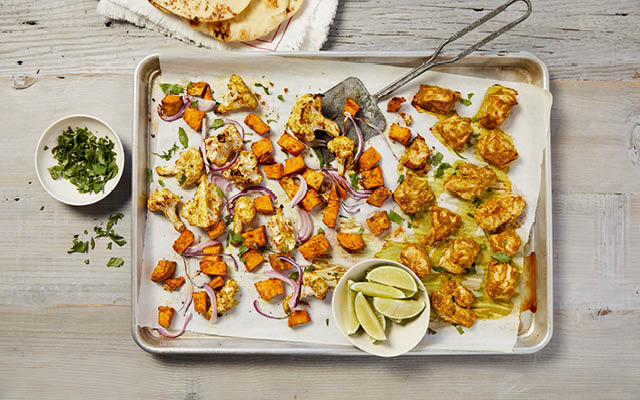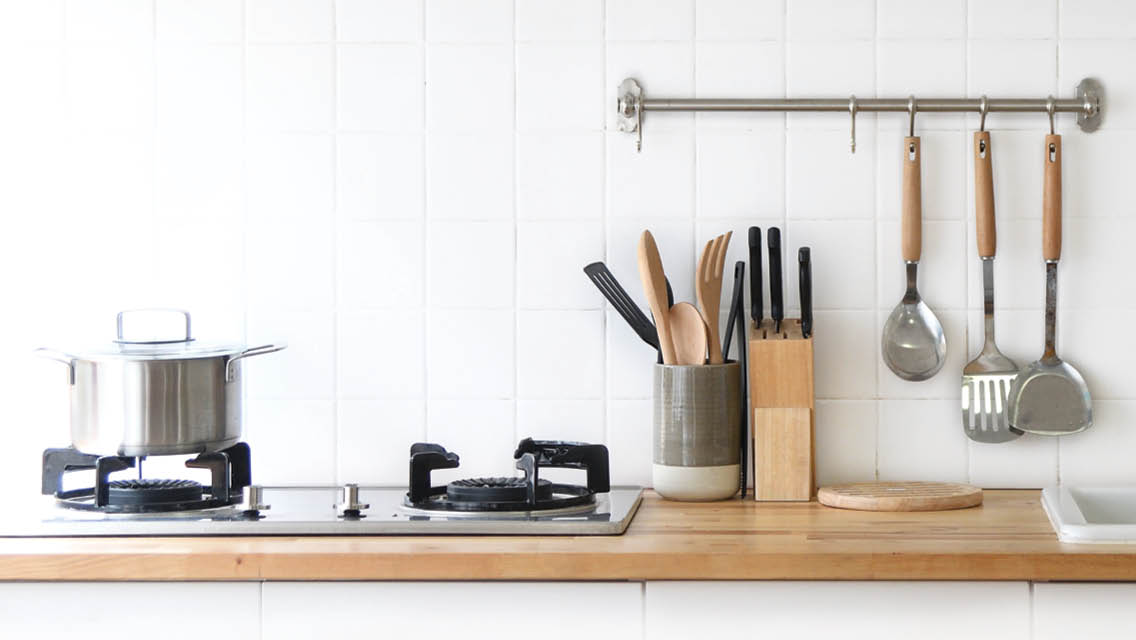One day about 10 years ago, I was sweating away on a stair-climber at the club, listening to two conversations occurring on either side of me. One was about exercise, the other was about cooking.
On my left, a personal trainer was urging his client to use good form in order to squeeze the most benefit from the energy she was expending. He patiently explained that dozens of improper reps of a given exercise might deliver a mere 20 percent of the benefit that just a handful of properly executed movements could.
Meanwhile, on my right, another trainer was listening to her client talk about food. The client was complaining that he wanted to eat properly but was tired of having broiled skinless chicken breasts each night for dinner and had no idea how to cook anything more interesting.
Suddenly, a light bulb exploded in my head: What most people need in the way of culinary education, I suddenly realized, isn’t loads of fancy recipes and a vast array of food knowledge, or even tons of practice – it’s basic, high-efficiency cooking skills. They need skills that let them get the most enjoyment from minimal time and energy expended in the kitchen. Duh: The answer lies not in mastering a series of recipes, but in understanding cooking principles.
That breakthrough has had an impact on my teaching philosophy ever since.
Empowered Eating
Based on my experiences teaching cooking, here’s what I know: Teach a man a steamed sea bass recipe and he can eat tonight. Teach him the principles of steaming seafood and he can eat forever!
Below, I have tried to answer just a few of the most common questions that home cooks regularly ask. But of course there are many, many more. Anyone interested in probing this subject more deeply would do well to consult James Beard’s Theory and Practice of Good Cooking – still the best book ever written about the why’s and how’s of cookery.
Another recommendation for further study: Sally Schneider’s A New Way to Cook, a modern approach to many of the same issues that Beard covers in his ’70s masterwork. Now, for the questions …
What are the most essential skills people need to learn in order to cook competently for themselves and their families?
- Begin with knife skills. Believe it or not, practicing cutting a carrot and an onion each day will improve your knife skills to the point that what was once drudgery will become an enjoyable part of the process. Everyone’s biggest complaint is being time-poor, and we shy away from recipes that have lots of prep time. Good knife skills make that a moot point.
- Reading a recipe is the most overlooked piece of the equation. I read them through twice, gathering my ingredients, equipment and imagining the finished product in my head. The habit of organizing myself this way, as opposed to just cooking willy-nilly and reading as I go, saves big chunks of time and eliminates costly error.
- Other biggies include menu planning (“cook once, eat twice” meals like roast chicken work best) and shopping discipline (buy only what is on your list and pass on impulsive last-minute purchases that derail meal-planning objectives). Last but not least, minimize self-criticism. Remember, it’s just food, and the dishes that don’t work out are often the ones we learn the most from. Go easy on yourself: Cooking is supposed to be fun.
What kinds of dishes are easiest and most rewarding to make?
- I find that simple recipes that deliver more than one meal are the best ones to start with. Larger-format foods are also the most forgiving, insuring success each time. I like to braise a pot roast, roast a chicken, grill a bone-in pork loin, make a pot of chili, and so on. These meals make great second meals, and therefore are inherent time-savers. Tonight’s roast chicken is tomorrow’s chicken salad. I also like to set aside one night to cook foods that I will freeze for serving later on down the road. Making a gallon of chili requires no more effort than making a quart. Getting into the habit of cooking with one foot in the present and your eyes focused on the future is a huge time-saver.
How can I make “boring vegetables” more interesting?
- Try a few simple seasonings, like fresh herbs and fresh-ground spices. Carrots feel right at home sautéed with honey and curry, peas go nicely with mint or tarragon and spinach loves rubbing up against garlic and lemon zest. Braised greens are great with toasted sesame oil. Or try spraying vegetables with an olive oil mister and placing them on a cookie tray. Roast them at 500 degrees until tender. Broccoli, cauliflower, Brussels sprouts, beet quarters, asparagus all take a shine to this method.
- Combination cooking is great for relieving boredom: Try sautéing zucchini slices in a teaspoon of olive oil over very high heat, then throw in some fresh basil and oregano leaves and minced garlic, toss once or twice and spill it over a small platter of grilled eggplant slices and garnish with halved cherry tomatoes.
What cooking “tricks” do I need in my arsenal?
There aren’t really any magic bullets. If you just practice your knife skills and try to cook at least one new thing each week, you will exponentially increase your knowledge and skill base within a few months. Most home cooks also benefit from the following advice:
- Don’t play with your food — overstirring and moving food around too much doesn’t allow it to cook properly.
- Anything cooked in rapidly boiling water, from pasta to sweet corn, needs to be aggressively salted. I season my water until it tastes like contact lens saline solution or light seawater.
- Anything cooked on the bone tastes better, from fish to chicken. This allows more time for the food to be in contact with the cooking surface, and for the minerals in the bones to season from within – all of which means more flavor.
- Preheat your pans over medium heat for five minutes before sautéing or browning anything. Cold foods in cold pans create sticking issues and prevent foods from searing properly.
- Cooking fats and oils should be added sparingly and placed into the pan right before you are ready to sauté or pan cook. Lay all foods going into a pan away from you so that any spatters go to the far side of the stove and not on your forearms.
- Generically speaking, add seasoning and spices such as herbs and garlic after your main item has gone into the pan to avoid burning them and turning them bitter. Believe it or not, you run a far greater risk of this with dried spices than with allums such as onions and garlic.
- When slicing fruits and vegetables, safety comes first. Take a thin shaving off one side of your object so that it can sit flat on your cutting board. This insures stability and prevents dangerous slips and rollovers.
Get Saucy
I’m often asked how to sauté and sauce with ease. The key is all in the order of the ingredients to be added to the pan. One-pan meals such as the one below are fast and efficient, and whether you’re sautéing shrimp or chicken, the principles are all the same.
Here’s a simple recipe for a chicken dish:
- Preheat a 10-inch sauté pan, add a teaspoon of olive oil, swirl and brown two or three chicken breasts on both sides.
- Add 1 cup of sliced mushrooms and two minced shallots.
- Cook the vegetables for a minute and add a sprig of rosemary and 1/2 cup of Marsala. When it boils, add 1/2 cup of chicken stock and reduce the liquids to a simmer until it glazes around the chicken. Season and serve.
Again, you can make this dish with shrimp, fish or pork chops – just change the supporting cast and the cooking time.
Apple Cider Roasted Pork Shoulder
- 1 trimmed, natural pork shoulder @ 3 ½ pounds
- 2 tbs. flour
- 2 tbs. minced garlic
- 2 tsp. kosher salt
- 1 tsp. ground white pepper
- 3 tbs. fresh rosemary
- 2 apples, peeled and sliced
- 1 large minced yellow onion
- 1 cup Calvados
- 1 cup natural apple cider
- 3 tbs. olive oil
Directions
- Place olive oil in a large sauté pan over high heat. Combine the rosemary, flour, salt and pepper. Rub this mixture into the roast. Brown roast in the pan with the oil. Reserve the roast to a roasting rack set into a roasting pan. Place into a 450-degree oven for 20 minutes.
- Add onions, apples and garlic to the sauté pan, cook until lightly colored. Add the Calvados and cider and reduce by half at a medium boil. Pour this mixture into the bottom of the roasting pan.
- Turn oven down to 325 and cook for 90 more minutes, or up to two hours, basting each half hour. When roast is 175 to 180 degrees on a meat thermometer, it is done.
- Serve with the pan juices spooned over.
Braised Striped Bass “Portugaise”
- 3 pounds wild striped bass filet (snapper or halibut work well, also)
- 1/4 cup olive oil
- 1 tbs. dry oregano
- 2 pinches saffron
- 2 minced onions
- 1 green bell pepper, minced
- 5 garlic cloves, sliced
- 3 fresh bay leaves
- 8 anchovies
- 3 tbs. capers
- 16 ounces canned crushed tomatoes
- 1 pound linguica or andouille sausage
- 8 ounces fish stock
- 1/2 cup white wine
- 1/3 cup minced cilantro
- 1/3 cup minced parsley
- Juice of 1 lime and its zest
Directions
- Skin, trim and cube the bass into 1-inch chunks. Set aside.
- Place the olive oil into a large sauté pan with high sides. Put over high heat and add the sausage and brown, remove sausage, slice and reserve. Add the oregano, saffron, onion, pepper, garlic, bay anchovy, caper and reserved sausage. Cook for 3–4 minutes, and add the wine and tomato.
- Reduce liquids buy half and add the fish stock. Reduce liquids by half. Add the bass and simmer for 10 minutes, stirring occasionally until fish is cooked through.
- Season with the remaining ingredients and finish with salt and pepper.
Broiled Kasu Marinated Black Cod
- 1 quart plus one cup water
- 2 tbs. kosher salt
- 2 pounds black cod (sable fish) cut into 4 portions, skin on, preferably (Note: Halibut, snapper or striped bass works well also.)
- 1/2 pound kasu*, fermented sake lees (sediment from rice wine production)
- 1/4 cup brown sugar
- 2 tbs. miso
- 1/4 cup mirin
Directions
- Combine the quart of water and the salt. Add the cod and soak in the refrigerator for 45 minutes. Remove fish, discard water and dry the fish gently.
- In a work bowl, combine the remaining ingredients. Add the fish and marinate, covered in the fridge, for 2 days.
- Preheat broiler and remove fish from marinade. Place the fish on a no-stick broiler tray and cook for 10 minutes for every inch of thickness. Turning once carefully; do not burn the fish.
- Serve over soba noodles with minced scallions as garnish. Serve with the hot or cold broth as seasons dictate.
*Available from Mutual Fish: 206-322-4368





This Post Has 0 Comments